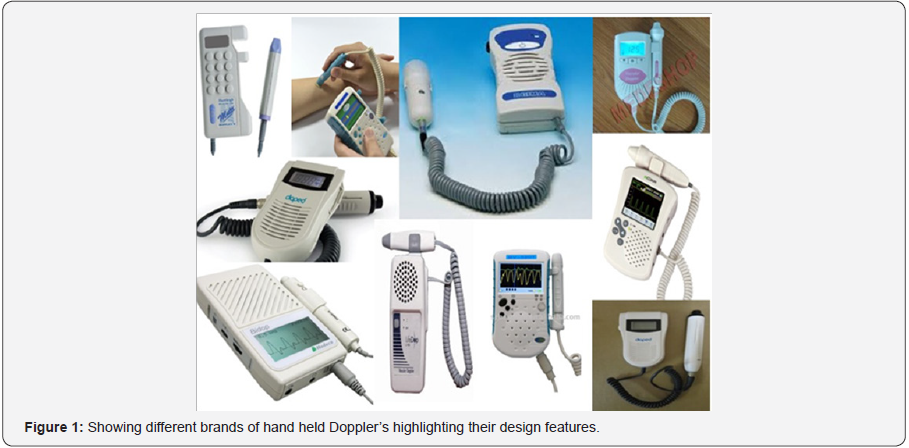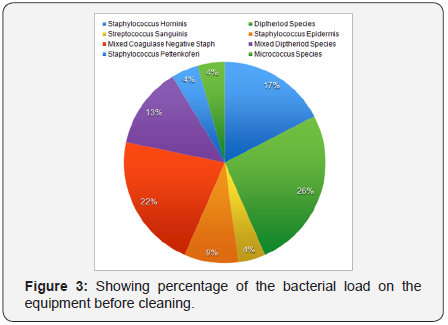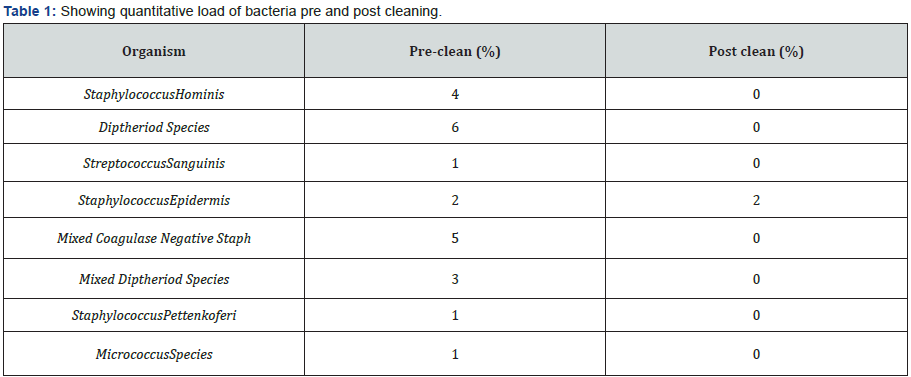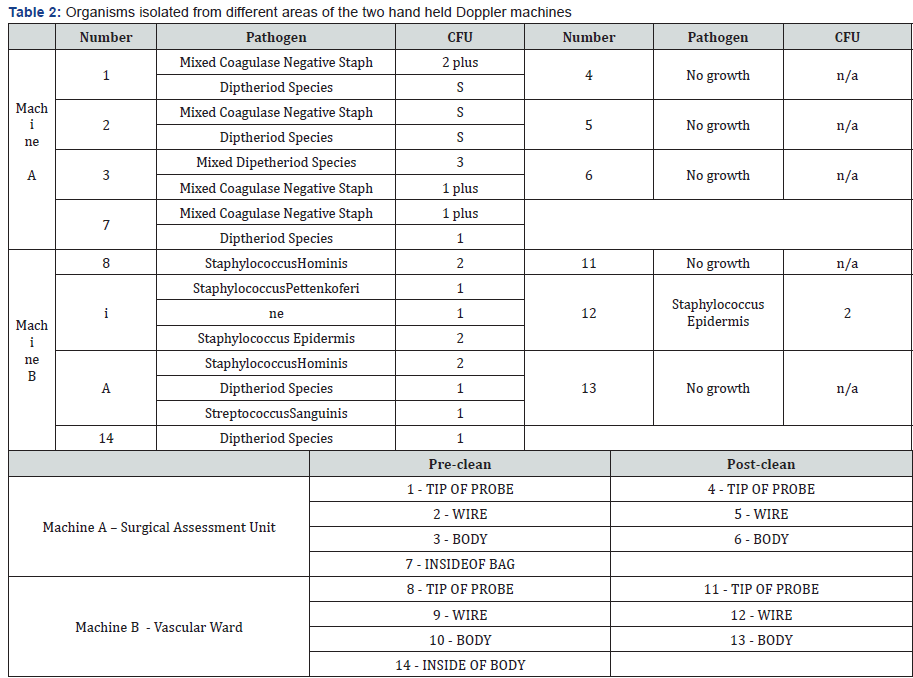Design of Hand Held Doppler: A Potential Source of Contamination!!
Muhammad Junaid Sultan1*, Kugili Sathanantham2, Rebecca Lumley3 and Peter Vowden4
1Department of Vascular Surgery, Bradford Royal Infirmary, UK
2Department of General Surgery, Foundation Year One Trainee, Bradford Royal Infirmary, UK
3University of Leeds, UK
4Visiting Honorary Professor of Wound Healing Research, Centre for skin sciences, School of Medical Sciences
University of Bradford, Bradford Royal Infirmary Hospital, UK
Submission: April 20, 2017;; Published: May 04, 2017
*Corresponding author: Muhammad Junaid Sultan, Vascular Surgery Registrar, Department of Vascular Surgery, Email: drjunaidsulthan@gmail.com
How to cite this article: Muhammad J S, Kugili S, Rebecca L, Peter V.Design of Hand Held Doppler: A Potential Source of Contamination!!. Open Access J Surg. 2017; 4(1): 555629. DOI: 10.19080/OAJS.2017.04.555629
Abstract
Aim: To evaluate if hand-held Dopplers harbour potential harmful bacteria and whether impractical design features facilitate this process.
Methodology:Bacterial culture swabs were obtained from three separate sites from the two hand-held Doppler machines on the Surgical Wards under aseptic measures. Swabs were collected from the tip of the probe, the main body of the Doppler machine and the coiled wiring connecting the two pieces. One sample was also obtained from the inside lining of each storage bag of the machines. The three regions of the Doppler probe were then cleaned with Chlor-Clean clinical wipes moistened with Actichlor Dilutions and one further set of swabs were obtained from each previous site for comparison.
Results: Both the machine were colonised with environmental bacteria: Diptheroidspecies, Staphyloccocusepidermis, Staphylococcushominis and Streptococcus Sanguinis. In total eight separate species were isolated following bacterial cultures. Lining of the machine bags grew Mixed coagulase species and Diptheroid species. In post cleaning samples, Staphylococcus Epidermis was found on the coiled wire of the Doppler device.
Conclusion: Hand held Doppler machines are contaminated and could be the potential source of hospital-acquired infections. Faulty design of the equipment facilitates this contamination and should be addressed and further evaluated.
Keywords: Hospital Acquired Infections; Hand Held Doppler; Disinfection
Abbreviations: WHO : World Health Organisation; HAI: Hospital Acquired Infection; MRSA; Methicillin resistant Staphylococcus Aureus; CPE: Carbapenemase producing Enterobacteriaceae
Introduction
The World Health Organization (WHO) describes a Hospital Acquired Infection (HAI) as ‘an infection occurring in a patient in a hospital or other health care facility in whom the infection was not present or incubating at the time of admission’ [1]. Current statistics estimate that the financial repercussions of nosocomial infections amounts to around one billion per annum [2]. HAIs cause considerable morbidity and mortality. A prevalence study conducted by WHO demonstrates that infectious complications seen in hospital are predominantly established in intensive care units and acute surgical wards [1].
Specifically, they have a detrimental effect in 2-9% of vascular patients undergoing surgery [2]. The complications that result include an extended length of hospital stay, failed surgical intervention requiring difficult revision, amputations and death [2]. More troublingly, hospital infections are becoming more challenging to treat with increasing rates of highly resistant strains of bacterial such as Methicillin resistant Staphylococcus Aureus (MRSA) evolving [1]. In light of this, the early detection and appropriate protocol to reduce the incidence of infection for each patient is central to avoiding unfavourable surgical outcomes and negative impact on patient’s quality of life.
At any one moment up to 9% of patients within the hospital setting have a HAI [2]. Whilst it is not feasible to prevent all infections, it has been proposed that with prudent implementation of infection control practices it is possible to eliminate at least 30% of these infections [3]. Previous papers have recognized that inanimate objects such as stethoscopes [4], doctors’ pens [5], case notes [6], hospital pagers [7], nurse’s scissors [8], and security swipe cards [9] are responsible for acting as reservoirs of bacteria. Other studies have theorized the causative relationship between hand-held Doppler usage and an attributed rise in infection rates on Vascular Surgical wards. There is already some evidence in the literature that hand held Dopplers are a possible source of contamination [10] and Sphygmomanometer cuffs have been shown to harvest multiple pathogenic bacteria [11]. With Hand-held Doppler machines being frequently utilised to assess arterial and venous blood supply in patients, and for them to be the potential source of bacterial contamination warrants further assessment for its design, which may contribute towards contamination. Similarly, simple measures of using disposable sphygmomanometer cuffs or for them to be wipeable could also reduce the infection.
The authors hypothesise that the design of hand-held equipment contributes to its potential to harbour bacteria. We investigated this by observing whether the shape of the site we obtained swabs from affected the concentration of pathogens subsequently cultured. One of the drawbacks in the design of the hand-held Doppler machine is the projections on the main body, which have no functional use, and a lengthy coiled wire extending from the body to the probe. In addition, another design feature, which makes cleaning difficult, is the presence of lip shaped counters on either sides of probe. These design features are demonstrable on almost all of the handheld Doppler machines offered by different manufacturers (Figure 1). In addition, the equipment is stored inside a bag lined by cloth, which cannot be easily cleaned after each use. There are no manufacturer guidelines as to how to clean these bags and after cleaning the device, it is stored again in the same potentially contaminated bag.

Hospitals implement strict disinfection protocols regarding hand hygiene, uniform, laundry, waste disposal etc. to reduce numbers of nosocomial infections. Equipment design can render these cleansing protocols ineffective. We propose that the unnecessarily intricate elements of the Doppler instrument make for difficult and therefore ineffective cleaning, are a contributing factor to cleansing failure. In effect, despite cleansing a contaminated Doppler machine can be used between successive patients and help introduce pathogens into already compromised soft tissue sites. The main purpose of this paper is to evaluate if it is the hand Doppler devices that are a main harvesting site for bacteria. By analyzing the percentages of bacteria existent on varying sites on the Doppler machine we have explored whether impractical design features facilitate this environment and more crucially, design an innovative diagnostic tool that is a functional as well as sterile. We could offer a device intended specifically to enable thorough examination of the vascular patient without causing harm and contributing to problematic HAIs.
Materials and Methods
This was a prospective experimental study. Bacterial culture swabs were obtained from three separate sites from the two hand-held Doppler machines operated on the Surgical Assessment Unit and the Vascular Ward. One single researcher obtained cultures from the allocated areas: the tip of the Doppler probe, the main body of the Doppler machine and the coiled wiring connecting the two areas (Figure 2). Sterile gloves were used while obtaining these swabs. The culture swabs were dipped in sterile water before taking swabs. One further sample was also obtained from the inside lining of each bag that the machines are stored in. All of the swabs were taken on the same day in one session. These sources were proposed to potentially harbour the most concentrated bacterial populations and were to be assessed without cleaning before patient exposure, as is current clinical practice. Current practice specifies cleaning the equipment after each use.

Three swabs were taken pre-cleaning from each designated site, the equipment was then cleaned with Chlor-Clean clinical wipes moistened with Actichlor Dilutions. Equipment was cleaned thoroughly and was left out to air dry for ten minutes. Only the inner lining of the bag was not cleaned, as there are no manufacturers instructions on cleaning methods. Washing the bag after each use was not feasible. After this three further swabs were obtained from the same three sites for comparison after cleaning. All the samples were anonymised in the laboratories and a special label set was generated for each of the swabs from the two machines both pre and post cleaning. For the following week, we also looked for any patients on the two wards who grew any organisms. This was only clinical observation and no further swabs were collected.
Results
The study was conducted in August 2015. All the data was collected and analysed electronically using Microsoft excel. The results conclusively indicated the presence of multiple pathogenic species. Both the machines were colonised with environmental bacteria, specifically: Diptheroidspecies, Staphyloccocusepidermis, Staphylococcushominisand StreptococcusSanguinis. In total nine separate species were isolated following bacterial cultures of swab specimens shown in Figure 3. The major isolates were Diptheroid Species (26%), followed secondly by the presence of Mixed coagulase species (22%). Bags were found to be a constant source of contamination and grew Mixed Coagulasespecies and Diptheroid species. In one case, as shown on (Tables 1 & 2), StaphylococcusEpidermis was identified from a sample taken from the coiled wire of the Doppler device even after the cleaning process. This particular device was predominantly in use on the Vascular Ward. During the one-week post sampling, one patient was identified to have grown MRSA and another patient was found to have Carbapenemase producing Enterobacteriaceae (CPE) but no direct link could be established between these results and the cultures obtained from the Doppler equipment.



Discussion
Our study has helped to illustrate that bacterial contamination of hand held Doppler machines is a valid cause for concern. The majority of pathogenic species identified had the potential to cause serious infection and contribute to the rising cost of surgical infections and complications. Impractical design contributes to the colonisation by these bacteria; as shown by the varying numbers and species of pathogenic organisms on the different sites of the hand held Doppler machines. Due to the limitations imposed by the current design the cleaning could not be easily carried out. This contributed to residual contamination after cleaning and subsequent HAI’s. The results are consistent with many previous studies that have shown inanimate objects such as doctor’s pens [5] and other fomites are cross contamination sites for many bacteria. One study that analysed Health care worker’s scissors as a potential source of infection found that 78.4% of them were colonized with bacteria. [8] This is consistent with our results that demonstrate that these inanimate objects such as hand held Dopplers and scissors can be a significant factor in nosocomial infections.
Our results demonstrate that the design of these hand held Doppler machines contributes to the colonisation of bacteria. Previous studies have also demonstrated that a fault in the design of hospital equipment can lead to the creation of harvesting sites for pathogenic bacteria [12]. This could be a major contributing factor to the outbreak of hospital-acquired infections. Other studies have also looked at the cleaning of Doppler probes and whether it is normally adequately performed on vascular wards. One study showed that usually the Doppler’s are not disinfected appropriately and hence educating staff of the appropriate cleaning methods can itself reduce contamination [2]. We felt confident that the results of our study were consistent with reality and could be replicated. All the swabs were collected by one researcher, which helped to minimize any variation in where the swabs were taken from.
The post cleaning swabs were taken on the same day as the pre cleaning samples, which reduced the amount of variation and avoided any bias. One of the main strengths in the design of this study was that swabs were taken from the inside lining of the bags containing the Doppler probes. This was critical when it came to the analysis of our results and it was found that the inside lining of the bags was one of the main harvesting sites for bacteria and there were no instructions on how to clean the bag. It was worrying that after cleaning, equipment was being stored in dirty environment. The main drawback of this study was that it had a small sample size. In future, we are aiming to obtain data from a much larger sample of hand held Dopplers. The study sample was not as a broad as we would have hoped for as the swabs were collected from only two locations, the surgical assessment unit and the vascular ward both situated within the Bradford Royal Infirmary. In a future study we would hope to replicate these results on a much wider scale looking at the results of colonisation in different trusts across Yorkshire.
The findings of this study highlight two important aspects. One demonstrated the need for clear protocols with regard to regular cleaning and usage of equipment by health care workers. The second is emphasis for manufacturers to consider improving design of this equipment. The manufacturer can consider improving design by replacing the coiled wire with retractable flat wire. It will take less space, reduce chances of contamination and easier to clean. The projections on the casing of the Doppler could be eliminated completely as they serve no function and are an ideal harbour site for bacteria. Thirdly the probe could be made flat with no dents inside it, which will make it easier to clean and make it difficult for bacteria to shelter there. Lastly the storage bag has to be replaced with plastic case, which could be cleaned properly. It is clear from this study that more needs to be done in terms of the design of hand held Doppler machines in order to minimise the colonization of harmful bacteria and reduce the amount of surgical complications.
This includes changing the design of equipment itself and also eliminating the need for using same sphygmomanometer. In market there is already a new device launched with the name of “BlueDop”, which offers promise at reducing this route of bacterial transfer. The BlueDop is a wireless Doppler that connects from the device to the tablet computer via Bluetooth technology [13]. This system not only solves the problem of the coiled wiring but also negates the need for the leg cuff that has been shown to harvest bacteria in previous studies [11].
Conclusion
Staphylococcus species are a potential source of Methicillinresistant Staphylococcus aureus (MRSA) and therefore infections that complicate 10% of hospital admissions. It is concerning that equipment so frequently used in the assessment of potential compromised patients with critical limb ischemia and open limb wounds is not easily or effectively cleaned. This can be attributed to design flaws and non-sterile holding equipment acting as a reservoir. It is evident even from this pilot study that hand held Doppler machines are contaminated and could be the potential source of hospital-acquired infections. Impractical design of the equipment facilitates this contamination and should be addressed.
Acknowledgement
The authors would like to thank Dr Campbell, Consultant Microbiologist and the Department of Microbiology at the Bradford Royal Infirmary for their support and advice during this study.
Authors Contributions
MJS designed the study and protocol, performed the study, collected data and analysis and written the manuscript and supervised the whole process. KS performed the study and took lead on analysis. She also contributed to manuscript writing and submission. RL helped with performing study and writing manuscript. PV helped in designing the study and protocol. He edited the final manuscript and supervised the whole process.
Conflict of Interest
The author’s decade that there are no competing interests associated with this manuscript.
References
- World Health Organization DOCD (2002) Prevention of hospitalacquired infections, A practical guide.
- Health DO (2000) The Management and Control of HAI in acute NHS Trusts in England.
- Health DO (1995) Hospital infection control: guidance on the control of infection in hospitals. Health Services Guidelines (95): 10.
- Milam MW, Pringle T, Buchanan K (2001) Bacterial contamination of the fabric of stethoscope covers: The velveteen rabbit of health care? Infect Control Hosp Epidemiol 22(10): 653-655.
- Datz C, JA Dusch H, Galvan G, Weiger T (1997) What’s on doctors’ ball point pens? Lancet 350: 1824.
- Bebbington API, James PA, Chichester LJ, Kubiak EM (2003) Patients’ case notes: look but don’t touch. J Hosp Infect 55: 299-301.
- Singh DKH, Gardner W, Treen L (2002) Bacterial contamination of hospital pagers.” Infect Control HospEpidemiol 23: 274-276.
- Embil JMZG, Plourde PJ, Hoban D (2002) Scissors: a potential source of nosocomial infection. Infect Control HospEpidemiol 23: 147-151.
- Sultan MJAA, Hindermash A, Greatorex RA (2009) Security swipe cards and scanners are a potential reservoir for hospital-acquired infection. Ann R CollSurg Engl 91(2): 155-158.
- Emma J Whitehead JFT, David R Lewis (2006) Contamination and Decontamination of Doppler Probes. Ann R CollSurg Engl 88(5): 479- 481.
- Zargaran D, Hardwick S, Adel R, Hill G, Stubbins D, et al. (2014) Sphygmomanometer Cuffs A Potential Source of Infection! Angiology 66(2): 118-121.
- Murphy JRRGHMR (2008) The Impact of Facility Design on Patient Safety. Chapter 28.
- Brennan D. The “egg” and the “brain” offer alternative to ankle brachial index measurement [Internet]. Vascular News.






























